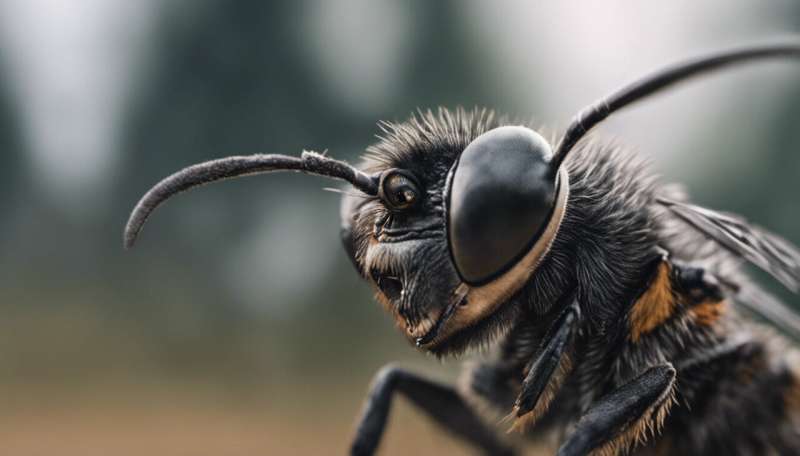This article has been reviewed according to Science X's editorial process and policies. Editors have highlighted the following attributes while ensuring the content's credibility:
fact-checked
trusted source
written by researcher(s)
proofread
How swarming animals can help humans and AI make better decisions

The word "swarm" often carries negative connotations—think biblical plagues of locusts or high streets full of last-minute shoppers during the Christmas rush. However, swarming is essential for the survival of many animal collectives. And now research into swarming has the potential to change things for humans too.
Bees swarm to make their search for new colonies more effective. Flocks of starlings use dazzling murmurations to evade and confuse predators. These are just two examples from nature but swarming can be seen in almost every corner of the animal kingdom.
Research from mathematicians, biologists and social scientists is helping us understand swarming and harness its power. It's already being used for crowd control, traffic management and to understand the spread of infectious diseases. More recently, it's starting to shape how we use data for health care, operate drones in military conflicts and has been used to beat near-insurmountable betting odds in sporting events.
A swarm is a system that is greater than the sum of its parts. Just as many neurons form a brain capable of thought, memory and emotion, groups of animals can act in unison to form a "super brain," displaying highly complex behavior not seen in individual animals.
Artificial life expert Craig Reynolds revolutionized the study of swarming in 1986 with the publication of the Boids model computer simulation. The Boids model breaks down swarming into a simple set of rules.
The Boids (bird-oids) in the simulation, like avatars or characters in a video game, are instructed to move in the same direction as their neighbors, move towards the average position of their neighbors, and avoid collisions with other boids.
Boids simulations are strikingly accurate when compared with real swarms.
The Boids model suggests that swarming does not need leaders to coordinate behavior—like pedestrians in a town center rather than a guided museum tour. The complex behavior we see in swarms arises from interactions between individuals following the same simple rules in parallel. In the language of physics, this phenomenon is known as emergence.
The hive mind
In 2016, US technology company Unanimous AI used the power of swarm intelligence to win the Kentucky Derby "superfecta" bet, successfully predicting the first, second, third and fourth-placed riders in the famous US horse race.
Industry experts and conventional machine learning algorithms made swathes of incorrect predictions. However, amateur racing enthusiasts recruited by Unanimous AI pooled their knowledge to beat the 541/1 odds.
The volunteers' success lay in the way in which their predictions were generated. Instead of voting on riders and aggregating their choices, the volunteers used Unanimous AI's swarm intelligence platform to participate in a real-time digital tug of war, inspired by swarms of birds and bees.
All volunteers simultaneously pulled a dial towards their respective choices. This allowed people to change their preferences in response to the actions of others (for example, a person may have switched to pulling towards their second choice, B, rather than their first choice, C, if they saw A and B were the clear favorites).
Responding to one another in real time allowed Unanimous AI's volunteers to collectively outperform highly-informed individuals.
What's more, had the most frequent individual picks of the volunteers determined the ordering, only the 2016 winner and bookies' favorite, Nyquist, would have been placed correctly.
Health concerns
Similar swarming technologies are also of increasing interest in the health care sector, where talk of an AI revolution is prompting increasing concerns around patient privacy.
As the reliance on data-driven techniques in health care increases, so too does the demand for extensive patient datasets. One way to meet these demands is to pool information between institutions and in some cases, countries.
However, the transfer of patient data is often subject to stringent data protection regulations. A solution to this problem is to use only in-house data, though this often comes at the expense of diagnostic accuracy.
An alternative lies in swarming. Researchers believe swarm intelligence can preserve diagnostic accuracy without the need for raw data exchange between institutions.
Preliminary studies have shown decentralizing data storage into a network of interacting nodes can give institutions the benefit of shared wisdom. This means there isn't a central hub coordinating the flow of information, and institutions can't access the private patient data of each other.
Centralized machine learning uses data uploaded to a shared hub where machine learning takes place using all available data. In decentralized systems, each institution separately stores its data in its own node. The machine learning happens locally at each node (using only in-house data), but the results of machine learning are shared between the network, to the benefit of all nodes. This process ensures that raw patient data is not exchanged between institutions, preserving patient privacy.
Swarms and warfare
Drone technology is increasingly used in front-line combat, in recent times most notably by Ukrainian forces in the ongoing Russia-Ukraine conflict. However, as it stands, conventional drone technology requires one-to-one supervision.
Current defense research aims to facilitate communication between drones, allowing one controller to operate swarms of drones. The development of such technology promises to vastly improve the scalability, reconnaissance and striking capabilities of combat drones by allowing for continuous information relay within groups of drones.
As research delves deeper into swarming, we find a world where collective action creates complexity, adaptability, and efficiency. As technology evolves, the role of swarm intelligence is set to grow, intertwining our world with the fascinating dynamics of swarms.
This article is republished from The Conversation under a Creative Commons license. Read the original article.![]()




















